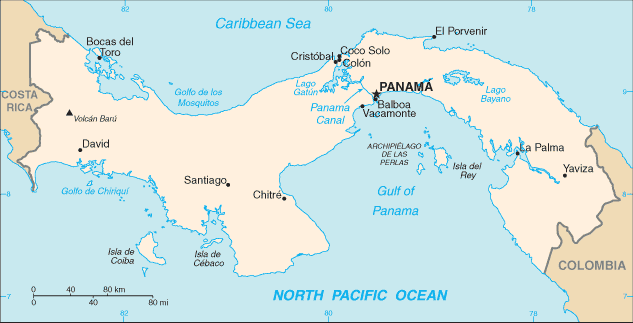 |
usa | world | animals | vocabulary | health | science | math | history |

Map Courtesy CIA World Factbook
Panama (Spanish: Panamá) is the southernmost country of Central America. It constitutes the last part of a natural land bridge between the North American and South American continents. It borders Costa Rica to the west and Colombia to the east.
Indeed much of Panama's domestic politics and international diplomacy in the 20th century were tied to the Panama Canal. At the turn of the 20th century, Theodore Roosevelt pursued United States diplomatic efforts to facilitate a deal that would allow it to take over French canal operations started by Ferdinand de Lesseps. In November 1903, political and naval maneuverings by the United States helped a small number of Panamanian rebels to secede from Colombia. On November 3, the rebels installed Manuel Amador Guerrero as President and declared Panama an independent Republic. The new republic was immediately recognized by the United States, and within three weeks, representatives of the fledgling republic signed the Hay-Bunau Varilla Treaty which granted rights to the United States to build and administer the Panama Canal. This treaty became a contentious diplomatic issue between the United States and Panama until the signing of the Torrijos-Carter Treaties in 1977.
The Panamanian government went through periods of political instability and corruption and at various times in its history, the mandate of an elected president terminated prematurely. In 1968, Gen. Omar Torrijos toppled the government of the recently elected Arnulfo Arias Madrid and became the virtual uncontested leader of Panama until his death in an airplane accident in 1981. After Torrijos's death, power eventually became concentrated in the hands of Gen. Manuel Noriega. Relations with the United States government soured by the end of the 1980s.
In December 1989, the United States invaded Panama in a large military operation codenamed Operation Just Cause involving 25,000 United States troops. Ostensibly, the death of a U.S. soldier in Panama at a Panamanian Defense Forces roadblock was one of the precipitating causes for the invasion,. However, according to the Panamanian government at the time, the officer's vehicle attempted to drive through the roadblock which was located near a sensitive military location. A few hours after the invasion, in a ceremony that took place inside a US military base in the former Canal Zone, Guillermo Endara was sworn in as the new president of Panama. The invasion occurred just days before the Panama Canal administration was to be turned over to Panamanian control, according to the timetable set up by the Torrijos-Carter Treaties. After the invasion, Noriega sought asylum in the Vatican diplomatic mission, but after a few days turned himself in to the American military. Noriega was immediately taken to Florida where he was formally charged and arrested by United States federal authorities.
Charges of corruption and cronyism still continue to be levelled against the government by opposition parties and press.
Under the Torrijos-Carter Treaty, on December 31, 1999, the United States returned all canal-related lands to Panama. Panama also gained control of canal-related buildings and infrastructure as well as full administration of the canal.
This article is licensed under the GNU Free Documentation License. It uses material from the Wikipedia article "Panama".